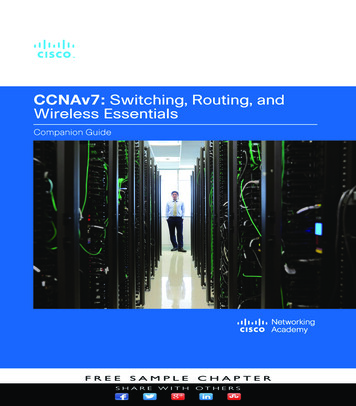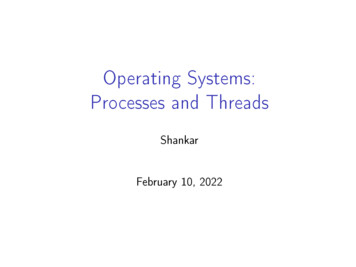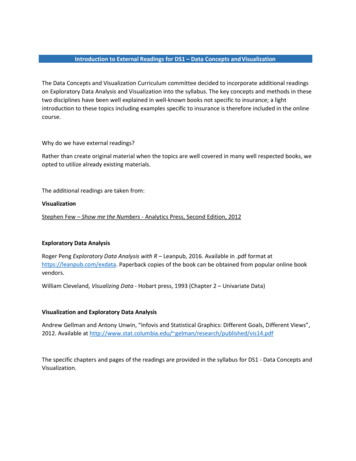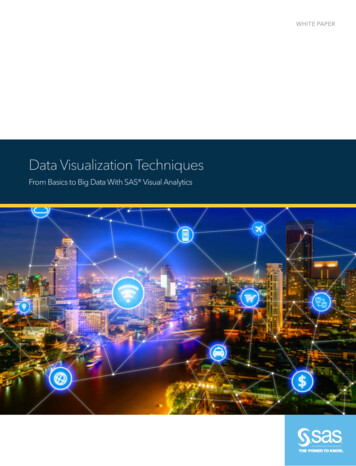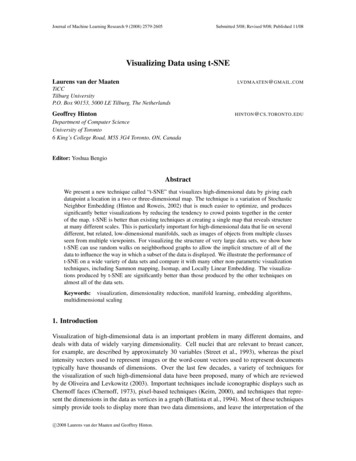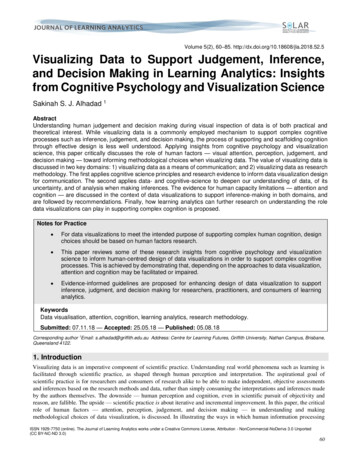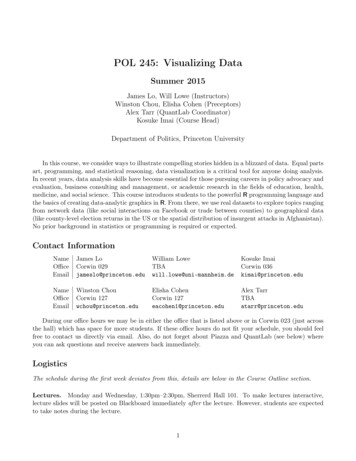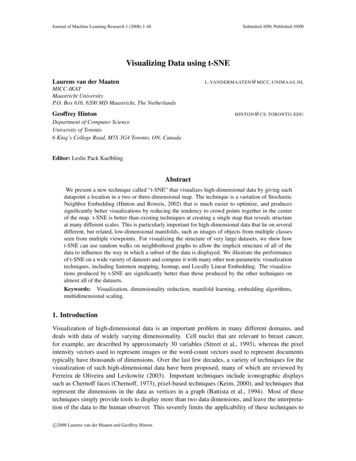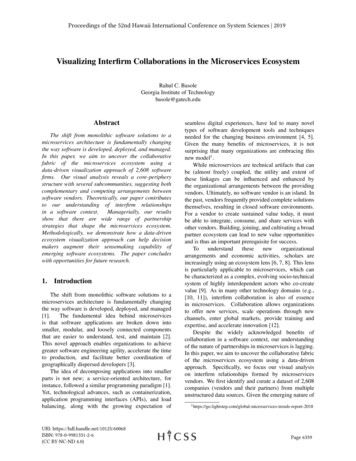
Transcription
Proceedings of the 52nd Hawaii International Conference on System Sciences 2019Visualizing Interfirm Collaborations in the Microservices EcosystemRahul C. BasoleGeorgia Institute of Technologybasole@gatech.eduAbstractThe shift from monolithic software solutions to amicroservices architecture is fundamentally changingthe way software is developed, deployed, and managed.In this paper, we aim to uncover the collaborativefabric of the microservices ecosystem using adata-driven visualization approach of 2,608 softwarefirms. Our visual analysis reveals a core-peripherystructure with several subcommunities, suggesting bothcomplementary and competing arrangements betweensoftware vendors. Theoretically, our paper contributesto our understanding of interfirm relationshipsin a software context.Managerially, our resultsshow that there are wide range of partnershipstrategies that shape the microservices ecosystem.Methodologically, we demonstrate how a data-drivenecosystem visualization approach can help decisionmakers augment their sensemaking capability ofemerging software ecosystems. The paper concludeswith opportunities for future research.1.IntroductionThe shift from monolithic software solutions to amicroservices architecture is fundamentally changingthe way software is developed, deployed, and managed[1].The fundamental idea behind microservicesis that software applications are broken down intosmaller, modular, and loosely connected componentsthat are easier to understand, test, and maintain [2].This novel approach enables organizations to achievegreater software engineering agility, accelerate the timeto production, and facilitate better coordination ofgeographically dispersed developers [3].The idea of decomposing applications into smallerparts is not new; a service-oriented architecture, forinstance, followed a similar programming paradigm [1].Yet, technological advances, such as containerization,application programming interfaces (APIs), and loadbalancing, along with the growing expectation ofURI: https://hdl.handle.net/10125/60068ISBN: 978-0-9981331-2-6(CC BY-NC-ND 4.0)seamless digital experiences, have led to many noveltypes of software development tools and techniquesneeded for the changing business environment [4, 5].Given the many benefits of microservices, it is notsurprising that many organizations are embracing thisnew model1 .While microservices are technical artifacts that canbe (almost freely) coupled, the utility and extent ofthese linkages can be influenced and enhanced bythe organizational arrangements between the providingvendors. Ultimately, no software vendor is an island. Inthe past, vendors frequently provided complete solutionsthemselves, resulting in closed software environments.For a vendor to create sustained value today, it mustbe able to integrate, consume, and share services withother vendors. Building, joining, and cultivating a broadpartner ecosystem can lead to new value opportunitiesand is thus an important prerequisite for ents and economic activities, scholars areincreasingly using an ecosystem lens [6, 7, 8]. This lensis particularly applicable to microservices, which canbe characterized as a complex, evolving socio-technicalsystem of highly interdependent actors who co-createvalue [9]. As in many other technology domains (e.g.,[10, 11]), interfirm collaboration is also of essencein microservices. Collaboration allows organizationsto offer new services, scale operations through newchannels, enter global markets, provide training andexpertise, and accelerate innovation [12].Despite the widely acknowledged benefits ofcollaboration in a software context, our understandingof the nature of partnerships in microservices is lagging.In this paper, we aim to uncover the collaborative fabricof the microservices ecosystem using a data-drivenapproach. Specifically, we focus our visual analysison interfirm relationships formed by microservicesvendors. We first identify and curate a dataset of 2,608companies (vendors and their partners) from multipleunstructured data sources. Given the emerging nature of1 ds-report-2018Page 6339
the microservices ecosystem, our dataset contains bothpublicly-listed and privately-held firms. We use a visualanalysis approach as it has been shown to be particularlyvaluable for discovery, exploration, and sensemakingfor relatively unknown contexts and complex datasets[11, 10, 13, 14].Theoretically, our study contributes to our generalunderstanding of interfirm relationships in a softwarecontext revealing the existence of a core-peripherystructure. Managerially, our results show that thereare wide range of partnership strategies employed byvendors – including differences in partner network size,partner network composition, and emphasis on core andperipheral vendors. Methodologically, we demonstratehow a data-driven ecosystem visualization approachcan help decision makers augment their sensemakingcapability of emerging software ecosystems.Asmicroservices continue to evolve, such a capability willallow decision makers to prepare, anticipate, or mimicsuccessful partnership strategies.The remainder of the paper is organized as follows.Section 2 reviews related work. Section 3 presentsour methodology, including our data curation process,metrics, and visualizations. Section 4 presents theresults. We discuss our findings from the vendor,partner, and developer perspectives in Section 5.We conclude with implications and future researchopportunities in Section 6.2.Related WorkFor our study of the microservices ecosystem, wedraw on three traditionally separate research streams,namely interfirm relationships, software ecosystems,and microservices.2.1.Interfirm RelationshipsFirms face a difficult challenge to effectivelycompete on their own in an increasingly dynamic,turbulent, and hypercompetitive business environments[15]. Resources, knowledge, and capabilities necessaryto innovate and succeed are often distributed amongother firms [6, 8]. It is this reality that requires firms,irrespective of size, financial resources, and industry,to engage in interorganizational relationships with aheterogeneous set of partners to gain access to novel andcomplementary capabilities, knowledge and resources[16]. Broadly considered, interfirm networks can beconsidered complex webs of ties interconnecting firmswithin and across industries [17]. Each firm in thenetwork is endowed with a diverse set of capabilitiesand resources. It has been argued that networks act asboth channels and prisms through which these resourcesflow and knowledge is shared [18, 19]. Relationshipsare formed for exploratory or exploitative reasons.Exploratory relationships are formed to create newwhile exploitative relationships are formed to executeexisting knowledge, functions, and activities [20].2.2.Software EcosystemsInterfirm relationships play a particularly criticalrole in the software industry [21, 22, 23, 24]. In theearly days of software engineering, the development ofa software product was commonly the result of a singleindependent software vendor creating a “monolithicproduct” [25]. Modern cloud-based software productson the other hand rely on many different componentsand infrastructures provided by a range of third partyvendors and open source suppliers. It is this changein business models that has transformed the softwaredevelopment landscape into a highly interconnectedecosystem characterized by a myriad of complexrelationships between software vendors [12, 21].Similar to its biological metaphor, value in asoftware ecosystem is co-created by a range of actors.The success of a software vendor is consequentlyco-dependent on the relationships it maintains with otherplayers in the ecosystem. Since firms can operate in oneor more layers of the software stack, it is not unusual fortwo software vendors to collaborate on one activity leveland compete in another.Research on software ecosystems has been gainingprominence since the seminal work by Messerschmittand Szyperski [26]. Prior studies have focused on avariety of topics and themes, including the architectureof the underlying software, the management andgovernance of software ecosystems, and the structureand dynamics of interfirm relationships in softwareecosystems. Research on software architecture isconcerned with the technical design and configurationof the interfaces and components. Studies include anexploration of the requirements of software as well asthe importance of modularity and flexibility. Researchon the management and governance of softwareecosystems focuses on how software ecosystems areorganized, monitored, and orchestrated, including anexploration of the rules and mechanisms that shapehealthy software ecosystems. The third focus areainvolves an examination of roles actors assume insoftware ecosystems and relationships between them.Prior work has identified many different roles, includingorchestrators or keystones, niche players, and externalactors. It is the interaction between these actors thatdefine the trajectory of software ecosystems. Differenttypes of ecosystems use different interaction models.Page 6340
2.3.MicroservicesThe scholarly investigation of microserviceshas primarily been a technical endeavor limited tothe software engineering, service engineering, andcloud computing disciplines [4]. Prominent topicshave included the design, testing, configuration andmanagement, migration, identification, and deploymentof microservices [27, 28, 1, 29].To the best of our knowledge, studies on the broaderorganizational strategies and implications associatedexplicitly with microservices have yet to emerge.2However, IS scholars are increasingly recognizing theimportance of services, service-oriented architectures,and service management for digital transformation [30,31, 32, 33, 34]. Our study aims to fill this gap byexamining supply-side partnering strategies by majorvendors.3.MethodologyFollowing [35], we use a data-driven approach toidentify and curate a dataset of interfirm collaborationin the microservices ecosystem (see Figure 1). To thebest of our knowledge, there are no comprehensivedata sources that capture microservices vendors. Ouridentification of core vendors and their partners(Step 1) thus started with extracting firms from twoprominent microservice vendor market maps providedby Sequoia Capital (2016)3 and Nanoscale (2017)4 anda list of vendors participating in the Cloud NativeComputing Foundation landscape (2017)5 . Together,these maps/lists provide an excellent starting pointas they organize vendors into broad categories6 andprovide a triangulated perspective of relevant focalactors in the microservices ecosystem. Rather thanusing all vendors, we used firms that co-appeared in thethree lists for cross-validation purposes.After removing duplicates and consolidating namesby the ultimate parent, our core dataset contained131 unique vendors. For each of these vendors,if available, we identified the partner page on theircorporate website and extracted all of the partner namesusing a semi-automated approach. If only logos were2 A keyword search of “microservices” in studies published in theIS Senior Scholar’s Basket of Journals revealed no results.3 ervices/4 https://www.nanoscale.io/ecosystem/5 https://github.com/cncf/landscape6 The maps/lists organize vendors by many different categories,including Orchestration, API Management, Platform Management,Load Balancing, Container Registry, Monitoring, and Log Analysis.However, there is no consensus between these categories and manycategory labeling differences exist. Moreover, vendors can appear inone or more categories. We did not consider these categories in ourstudy and further analysis on these categorical assignments are needed,but beyond the scope of this paper.provided, and the company name was not directlydiscernible, we used a reverse image search using theGoogle Cloud Vision API7 to determine the partnername. If available, we also noted the type of partnershiplevel between the two companies (e.g., technology,strategic, channel/reseller, system integrator, etc.). Oncewe had curated a list of vendor-partner pairs, we useda fuzzy match algorithm to match and resolve anyambiguities in partner names. This resulted in a totalof 2,583 unique partner names.Next, we modeled the microservices ecosystem asan undirected network, with nodes representing firms(vendors and their partners) and edges representingpartnerships between these firms (Step 2). We scalededges proportional to the number of relationship types(each type receiving the same weight) between twofirms. We then computed various network metricsto gain insight into the topological structure of theecosystem (Step 3). Specifically, following [10, 21, 36]we measured density (the proportion of ties that arerealized in the network relative to the hypotheticalmaximum possible), average degree (the averagenumber of partnerships each firm has), average weighteddegree (average of sum of weights of edges connectedto nodes in the network), modularity (number ofsubcommunities in the network defined as firms thatare more densely connected together than to the restof the network)8 , network diameter (shortest distancebetween the two most distant firms in the network), andaverage path length (the average number of steps alongthe shortest paths for all possible pairs of firms).We used Gephi 0.92, an open-source graphvisualization software, to visualize the network [38](Step 4). We used OpenORD, a cluster emphasizinglayout algorithm, to depict the overall ecosystemstructure [39] and applied the NoOverlap heuristic tominimize node occlusion, thereby improving the overallreadability and aesthetics of the graph. In all of ourvisualization, we sized nodes proportionally to theirbetweenness centrality (the positional prominence of afirm in the network) [40].Lastly, to make sense of the resulting visualizationsand to understand implications for practice, weconducted semi-structured interviews with softwaredevelopers, vendors, and consultants (Step 5). Ourfive respondents provided qualitative feedback on thevisualizations associated with their understanding of theindustry.7 https://cloud.google.com/vision/8 We applied Louvain’s community detection algorithm to identifysubcommunities in the ecosystem [37].Page 6341
Figure 1. Data-Driven Ecosystem Visualization Approach (adapted from [36]).4.ResultsTable 1 shows summary statistics of key structuralmetrics for the entire microservices partner ecosystem(2,608 firms) and for core vendors only (131 firms).In total, there are 3,510 unique partnerships, with 239among vendors only. The average number of partners(average degree) each vendor has is 6.128. The averagepath length, which indicates the average number ofhops each firm has to take from another is 2.546. Thedensity, which is the ratio of existing partnerships overall possible partnerships, is 8% for the core vendornetwork. Together, these metrics suggest that vendorsform a highly interconnected core and operate in a smallworld-like context.Table 1. Summary Statistics of InterfirmCollaboration in the Microservices Ecosystem.Ecosystem MetricOverall Vendors age Degree2.6126.128Average Weighted Degree 2.8736.59Modularity0.2590.293Network Diameter75Average Path Length3.8072.546Figure 2 shows the corresponding visualization ofthe microservices ecosystem. For readability purposes,we only depict the main component (largest-connectedsubgraph) and focus the labels on the core vendors.This eliminates vendors that have no partners or are notconnected to the core activities in the ecosystem. Wedifferentiate core vendors and partners using two-huecolor-encoding. Microservices vendors are depictedin red; partners are depicted in gray. Nodes (andnode labels) are sized proportionally to their level ofbetweenness centrality, a graph theoretic measure thatcaptures the relative importance of an entity in thebroader ecosystem. Several interesting observations canbe made from this graphical depiction.First, there are several centrally prominent vendorsin the microservices ecosystem.These includeAtlassian, Openshift, Kubernetes, and Docker. Eachof them have a rich partner network that resembles asubecosystem. More peripheral players, with significantnumber of partners, include Mulesoft, Nagios, NewRelic, and Palo Alto. Most vendors operate relativelysmall to moderate partner network sizes. However,some players have significant partner collaborations,including Splunk, Atlassian, Nagios, and Mulesoft.Some vendors are only weakly connected to the maincomponent, including Tibco and Pubnub.Another important observation that can be madefrom the visualization is the large number of vendorsthat occupy a relatively central position but are notnecessarily prominent as measured by their partnernetwork. We have labeled these as the ecosystemcore. These vendors play an important coordinatingor enabling role with other microservices vendorsand come from key segments like the public cloud,infrastructure, and monitoring. Examples include AWS,Microsoft Azure, and Google Cloud.To more deeply understand the collaborativestructure among vendors only, Figure 3 filters outpartner nodes.We then rerun the force-directedlayout algorithm on this reduced dataset to identify thestructure of core and peripheral players and size nodesagain by their structural prominence. We clearly noticethe relative size of four vendor actors: Kubernetes,Openshift, Docker, and Microsoft Azure. We alsoobserve some deeper relationships (indicated by linethickness) between a few players, in particular Splunkand its partners.Furthermore, we use the Louvain communitydetection algorithm to distinguish subgroups andcolor-encode them according to subcommunitymembership. Our visualization reveals the presenceof six subcommunities that are more closelyinterconnected. The central (light green) core consistsof actors such as Google Cloud, Docker, MicrosoftAzure, Oracle, IBM, Mesosphere, and Dreamfactory(indicated by A). Kubernetes and its partners form alarge second subecosystem (indicated by B). The largestsubcommunity is depicted in purple, which includesOpenshift, jfrog, Smologic, Hashicorp, and Atlassian,among many others.Page 6342
Figure 2. Interfirm Collaboration in the Microservices Ecosystem (core vendors red, partner gray). Nodessized by Betweenness Centrality. Visualization reveals an ecosystem core and several large peripheral vendors thatare disconnected from core but maintain large partnership networks.5.DiscussionOur study contributes to the growing yet nascentliterature adopting a visual analytic view of emergingsoftware ecosystems.The visualizations provideimportant insights from three complementaryperspectives.5.1.Vendor PerspectiveSoftware vendors have the choice and opportunityto architect high-performing partner ecosystems byensuring that relationships with software partners arechosen and managed “wisely”, that partners are selectedappropriately such that it provides the opportunity forgreater collaboration, and that the “right” relationshipsare built, maintained, and cultivated. We postulatethat it may be more judicious to have a few goodrelationships, i.e., establish relationships with the rightpartners, who provide complementary or value-addedcapabilities and networks, rather than simply create alot of partnerships that do not provide significant value.Moreover, vendors can collaborate with both partnersand other major vendors to create subecosystems thatcan create compelling value propositions to companiesand developers. In doing so, they can create importantPage 6343
Figure 3. Collaboration between Vendors in the Microservices Ecosystem reveals several subcommunities amongvendors, including a core of major players (A: Docker, IBM, Google Cloud, Microsoft Azure), (B) aKubernetes-centric subecosystem, and (C) a set of public cloud vendors, security, and monitoring. Allcommunities are composed of different segments, suggesting competing subecosystems.fluid lock-in effects. The creation of such ecosystemsis important particularly as new entrants emerge andexisting power structure is shifted.gatekeepers. This result underlines the importance andrelevance of niche players advocated in prior ecosystemwork (e.g. [6])5.2.5.3.Partner PerspectiveAn equally important dual perspective includes thestrategies that partners use to position themselves in themicroservices ecosystem. Our visual analysis revealsthat many small partner firms tend to align themselvesalmost exclusively to a single vendor. On other otherhand, we also identify a few partner firms that positionthemselves more centrally between vendors, eitherhedging their risks or acting as important bridges andDeveloper PerspectiveWhile our study takes a vendor-centric view ofinterfirm collaboration, it needs to be acknowledged thatdevelopers play a crucial role in the overall evolutionof the microservices ecosystem.To understandour interfirm collaboration maps from a developers’perspective, we thus discussed our visualizations witha group of active microservices developers. Oneof the key insights that developers commented onPage 6344
is the surprising distribution of vendors across thecore-periphery structure of the ecosystem. In particular,it was commented that, while disconnected from aninterfirm collaboration perspective, developers tendto use and integrate microservices from both coreand peripheral vendors. In general, it was arguedthat developers do not think much about whichvendors collaborate, but rather whether the underlyingservices/technologies actually work together seamlessly.As such the real importance to developers is technologyintegration. Yet, developers were surprised to observethat some of the vendors were not collaborating closergiven the natural connection/integration between thevalue offerings they provide. The findings of the corevendor collaboration however aligned well with theirperspectives of the ecosystem. In general, developerssuggested that vendors should be more cognizantof developers’ needs and form interfirm strategiesaccordingly.natural extension of our work would be an examinationof the association of the collaborative structure andposition a vendor occupies with respect to firmperformance. Do the positions that firms occupy inthe ecosystem actually lead to differential performance(e.g., market share, revenue, traffic, etc.)? Fourth,another interesting area of research would be to examinethe structural footprint of different segments in themicroservices ecosystem. Do vendors concentrate ordistribute their efforts across different value segments?Fifth, microservices are geography-agnostic, yet mostvendors may be located in North America. Yet,given the global nature of software development andcross-border data policies, it would be interesting toexplore what geographic differences may exist. Lastly,from the conversation with developers it appears thatwhile interfirm collaboration provide novel insights,an equally important visualization would focus onmicroservices integrations.6.ReferencesConcluding RemarksThe shift from monolithic software solutionsto a microservices architecture is fundamentallychanging the way software is developed, deployed,and managed.In this paper, we uncovered thecollaborative fabric of the microservices ecosystemusing a data-driven visualization approach of nearly3,000 software firms. Our analysis revealed a clearcore-periphery structure, with significant collaborationsbetween core vendors. We also discovered that someplayers occupy a much more prominent position andsub-clusters exist. Theoretically, our paper contributesto our understanding of interfirm relationships ina software context.Managerially, our resultsshow that there are wide range of partnershipstrategies that shape the microservices ecosystem.Methodologically, we demonstrate how a data-drivenecosystem visualization approach can help decisionmakers augment their sensemaking capability ofemerging software ecosystems.Our paper provides a foundation for several futureresearch avenues. First, as with all ecosystems, themicroservices ecosystem is highly dynamic. Newentrants emerge and new relationships are formedconstantly. An important future research directionthus would include a temporal, evolutionary perspectiveon the ecosystem. Second, interfirm partnershipsare only one form of value creation that actors inthe microservices ecosystem can pursue. As morestartups emerge, we will see increased venture fundingand acquisition activities. An examination of thesealternative relationships would be fruitful. Third, a[1] S. Newman, Building microservices:Designingfine-grained systems. Sebastopol, CA: O’Reilly Media,2015.[2] J. Bosch, “Speed, data, and ecosystems: The future ofsoftware engineering,” IEEE Software, vol. 33, no. 1,pp. 82–88, 2016.[3] S. Jansen, M. A. Cusumano, and S. Brinkkemper,Software ecosystems: Analyzing and managing businessnetworks in the software industry. Northampton, MA:Edward Elgar Publishing, 2013.[4] N. Dragoni, S. Giallorenzo, A. L. Lafuente, M. Mazzara,F. Montesi, R. Mustafin, and L. Safina, “Microservices:yesterday, today, and tomorrow,” in Present and UlteriorSoftware Engineering, pp. 195–216, Springer, 2017.[5] R. C. Basole, “Accelerating digital transformation:Visual insights from the API ecosystem,” ITProfessional, vol. 18, no. 6, pp. 20–25, 2016.[6] M. Iansiti and R. Levien, The keystone advantage: Whatthe new dynamics of business ecosystems mean forstrategy, innovation, and sustainability. Boston, MA:Harvard Business Press, 2004.[7] R. Adner, “Ecosystem as structure: An actionableconstruct for strategy,” Journal of Management, vol. 43,no. 1, pp. 39–58, 2017.[8] M. G. Jacobides, C. Cennamo, and A. Gawer, “Towardsa theory of ecosystems,” Strategic Management Journal,vol. 39, no. 8, pp. 2255–2276, 2018.[9] M. de Reuver, C. Sørensen, and R. C. Basole, “Thedigital platform: A research agenda,” Journal ofInformation Technology, vol. 33, no. 2, pp. 124–135,2018.[10] R. C. Basole, “Visualization of interfirm relations in aconverging mobile ecosystem,” Journal of InformationTechnology, vol. 24, no. 2, pp. 144–159, 2009.[11] P. C. Evans and R. C. Basole, “Revealing the APIecosystem and enterprise strategy via visual analytics,”Communications of the ACM, vol. 59, no. 2, pp. 26–28,2016.Page 6345
[12] L. S. Gao and B. Iyer, “Analyzing complementaritiesusing software stacks for software industry acquisitions,”Journal of Management Information Systems, vol. 23,no. 2, pp. 119–147, 2006.[13] R. C. Basole, “Visual business ecosystem intelligence:Lessons from the field.,” IEEE Computer Graphics andApplications, vol. 34, no. 5, pp. 26–34, 2013.[14] R. C. Basole, A. Srinivasan, H. Park, and S. Patel,“ecoxight: Discovery, exploration, and analysis ofbusiness ecosystems using interactive visualization,”ACM Transactions on Management Information Systems,vol. 9, no. 2, pp. 6–26, 2018.[15] R. D’Aveni, Hypercompetition: Managing the dynamicsof strategic management. New York, NY: Free Press,1994.[16] P. J. Williamson and A. De Meyer, “Ecosystemadvantage: How to successfully harness the power ofpartners,” California Management Review, vol. 55, no. 1,pp. 24–46, 2012.[17] W. W. Powell, K. W. Koput, and L. Smith-Doerr,“Interorganizational collaboration and the locus ofinnovation: Networks of learning in biotechnology,”Administrative Science Quarterly, vol. 41, no. 1,pp. 116–145, 1996.[18] J. M. Podolny, “Networks as the pipes and prisms of themarket,” American Journal of Sociology, vol. 107, no. 1,pp. 33–60, 2001.[19] J. Owen-Smith and W. W. Powell, “Knowledge networksas channels and conduits: The effects of spilloversin the boston biotechnology community,” OrganizationScience, vol. 15, no. 1, pp. 5–21, 2004.[20] A. Parmigiani and M. Rivera-Santos, “Clearing a paththrough the forest: A meta-review of interorganizationalrelationships,” Journal of Management, vol. 37, no. 4,pp. 1108–1136, 2011.[21] B. Iyer, C.-H. Lee, and N. Venkatraman, “Managing ina small world ecosystem: Lessons from the softwaresector,” California Management Review, vol. 48, no. 3,pp. 28–47, 2006.[22] C.-H. Lee, N. Venkatraman, H. Tanriverdi, andB. Iyer, “Complementarity-based hypercompetition inthe software industry: Theory and empirical test,1990–2002,” Strategic Management Journal, vol. 31,no. 13, pp. 1431–1456, 2010.[23] N. Venkatraman, C.-H. Lee, and B. Iyer, “Interconnectto win: the joint effects of business strategy andnetwork positions on the performance of software firms,”in Network Strategy, pp. 391–424, Emerald GroupPublishing Limited, 2008.[24] B. Iyer, C.-H. Lee, N. Venkatramen, and D. Vesset,“Monitoring platform emergence: guidelines fromsoftware networks,” Communications of the AIS, vol. 19,no. 1, p. 1, 2007.[25] S. Jansen and M. A. Cusumano, “Defining softwareecosystems: a survey of software platforms and businessnetwork governance,” Software ecosystems: Analyzingand managing business networks in the softwareindustry, vol. 13, 2013.[26] D. G. Messerschmitt, C. Szyperski, et al., “Softwareecosystem: Understanding an indispensable technologyand industry,” MIT Press Books, vol. 1, 2005.[27] C. Pahl and P. Jamshidi, “Microservices: A systematicmapping study,” in International Conference on CloudComputing and Services Science, pp. 137–146, 2016.[28] A. Balalaie, A. Heydarnoori, and P. Jamshidi,“Microservices architecture enables devops: Migrationto a cloud-native architecture,” IEEE Software, vol. 33,no. 3, pp. 42–52, 2016.[29] E. Wolff, Microservices: Flexible Software Architecture.Crawfordsville, IN: Addison-Wesley Professional, 2016.[30] A. Rai and V. Sambamurthy, “Editorial notes: Thegrowth of interest in services management: opportunitiesfor info
Building, joining, and cultivating a broad partner ecosystem can lead to new value opportunities and is thus an important prerequisite for success. To understand these new organizational arrangements and economic activities, scholars are increasingly using an ecosystem lens [6, 7, 8]. This lens is particularly applicable to microservices, which can

